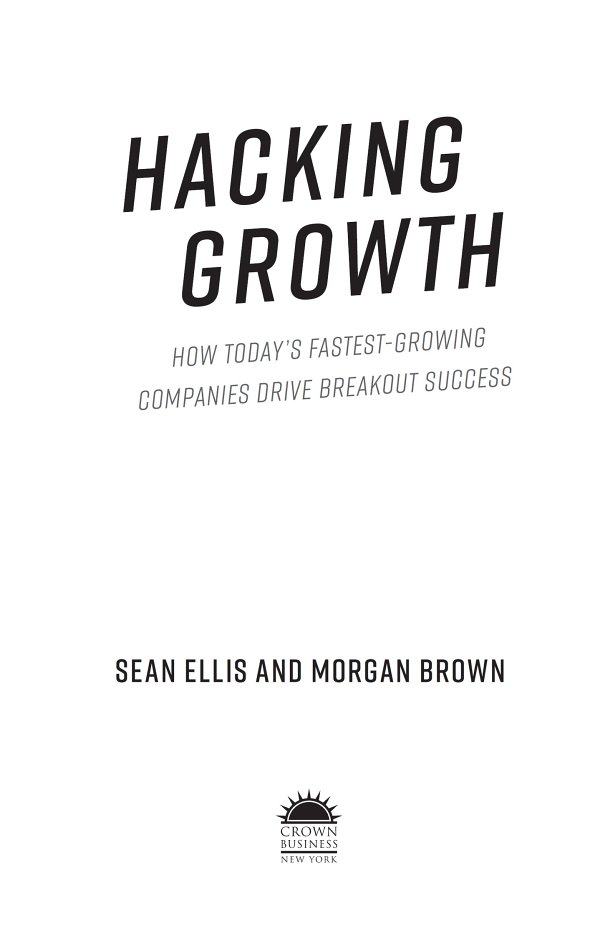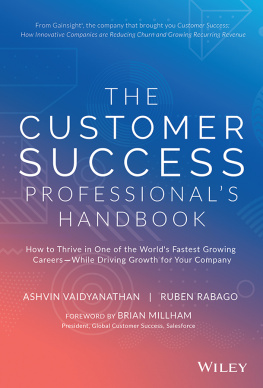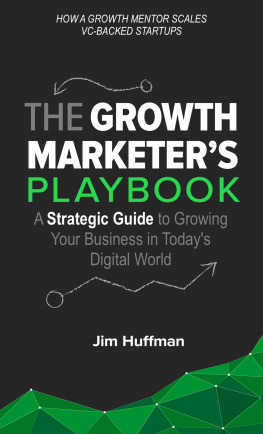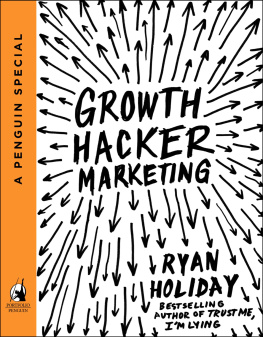Sean Ellis founder of GrowthHackers.com - Hacking growth : how todays fastest-growing companies drive breakout success
Here you can read online Sean Ellis founder of GrowthHackers.com - Hacking growth : how todays fastest-growing companies drive breakout success full text of the book (entire story) in english for free. Download pdf and epub, get meaning, cover and reviews about this ebook. year: 2017, publisher: Crown Business, genre: Business. Description of the work, (preface) as well as reviews are available. Best literature library LitArk.com created for fans of good reading and offers a wide selection of genres:
Romance novel
Science fiction
Adventure
Detective
Science
History
Home and family
Prose
Art
Politics
Computer
Non-fiction
Religion
Business
Children
Humor
Choose a favorite category and find really read worthwhile books. Enjoy immersion in the world of imagination, feel the emotions of the characters or learn something new for yourself, make an fascinating discovery.

- Book:Hacking growth : how todays fastest-growing companies drive breakout success
- Author:
- Publisher:Crown Business
- Genre:
- Year:2017
- Rating:3 / 5
- Favourites:Add to favourites
- Your mark:
- 60
- 1
- 2
- 3
- 4
- 5
Hacking growth : how todays fastest-growing companies drive breakout success: summary, description and annotation
We offer to read an annotation, description, summary or preface (depends on what the author of the book "Hacking growth : how todays fastest-growing companies drive breakout success" wrote himself). If you haven't found the necessary information about the book — write in the comments, we will try to find it.
Hacking growth : how todays fastest-growing companies drive breakout success — read online for free the complete book (whole text) full work
Below is the text of the book, divided by pages. System saving the place of the last page read, allows you to conveniently read the book "Hacking growth : how todays fastest-growing companies drive breakout success" online for free, without having to search again every time where you left off. Put a bookmark, and you can go to the page where you finished reading at any time.
Font size:
Interval:
Bookmark:


Copyright 2017 by Sean Ellis and Philip Morgan Brown
All rights reserved.
Published in the United States by Crown Business, an imprint of the Crown Publishing Group, a division of Penguin Random House LLC, New York.
crownpublishing.com
CROWN BUSINESS is a trademark and CROWN and the Rising Sun colophon are registered trademarks of Penguin Random House LLC.
Library of Congress Cataloging-in-Publication Data
Names: Ellis, Sean, author. | Brown, Morgan, author.
Title: Hacking growth : how todays fastest-growing companies drive breakout success / Sean Ellis, Morgan Brown.
Description: First Edition. | New York : Crown Business, 2017.
Identifiers: LCCN 2016044987 | ISBN 9780451497215 (hardback)
Subjects: LCSH: Success in business. | Consumer behavior. | Marketing. | BISAC: BUSINESS & ECONOMICS / Development / Business Development. | BUSINESS & ECONOMICS / Consumer Behavior. | BUSINESS & ECONOMICS / Marketing / Direct.
Classification: LCC HF5386 .E434 2017 | DDC 658dc23
LC record available at https://lccn.loc.gov/2016044987
ISBN9780451497215
Ebook ISBN9780451497222
International edition ISBN9781524760007
Illustrations by Mapping Specialists, Ltd.
Cover design by Oliver Munday
v4.1_r3
a
SE: Dedicated with love to my amazing wife Svetlana and our talented daughters Natasha and Anna.
MB: For Erika, Banks, and Audrey Grace




W hen I (Sean) got a call from Dropbox founder Drew Houston in 2008, I was immediately intrigued by the predicament the one-year-old start-up was in. The companys cloud-based file storage and sharing service had built up a good early fan base, concentrated primarily among the tech-savvy community centered in Silicon Valley. Even before the product was completely built, Houston had pushed a video prototype online illustrating how the service would work, which had earned him the backing of the powerful Y Combinator start-up incubator and drawn a flood of early adopters.
It became pretty clear that Houston was on to something when the waiting list he was keeping for the beta version grew from 5,000 to 75,000 in a blink of an eye when a second video was posted on news aggregator site capital raised by Houston. Meanwhile, behemoths Microsoft and Google were gearing up to enter the cloud storage arena. How could Dropbox grow their customer base in the shadow of such formidable competitors?
When Houston called me, he wanted to explore what I could do to help them grow beyond their very solid but not-yet-big-enough pool of early adopters. I was just wrapping up an interim VP Dropbox, the ads werent bringing in enough bang for the buck. Meanwhile, Sony, Yahoo!, and Microsoft started making their big push, flooding the Web with gaming ads, and as a young start-up, Uproar didnt have anywhere close to the money needed to compete with them head to head. I knew I had to find another way.
Thats when I got the idea of creating an entirely new type of advertisement that allowed Web proprietors to offer Uproar games for free on their site, meaning the site got fun new features to offer their visitors, and Uproar got exposure to everyone who visited those pages. Simon gave the go-ahead, and within a few weeks, the engineers and I had created a new single-player game that could be added to any website, with just a small snippet of code: one of the first embeddable widgets. The site proprietors would become Uproar affiliates, paid just $.50 for each new game player the company acquired through their sites. The low cost made it highly affordable for us and, because the game was so engaging, the affiliates were happy to feature it. In addition to sending new gamers to Uproar, we experimented with adding an add this game to your site link, which made it easy for other website owners to make the game available on their sites, too.
As we saw the game start to take off, we tested different versions of the copy, calls to action, and which free game we offered to find the most potent combination. The result for Uproar was explosive growth; the free games were soon on 40,000 sites and Uproar shot to the top of the online gaming world, beating out the behemoths and their splashy marketing campaigns. Many other companies have since used the same strategy to grow, the most famous example being YouTube, who later supercharged its growth by creating its embeddable video player widget, which landed YouTube videos all over the Web and turned online video into a phenomenon.
It was this success that led Uproar founder, Michael Simon, to ask me to come help grow his next venture, LogMeIn. LogMeIn was an ingenious product that let users access their files, email, and software on their home or work desktop computer from any other PC connected to the Internet. Yet while an aggressive search engine marketing campaign led to a good initial burst of customer sign-ups, they soon plateaued, and I realized that ads were once again proving far too costly for the payoffespecially since, at my suggestion, LogMeIn had pivoted from a paid to a freemium model in an effort to differentiate the service from its fierce competitor, GoToMyPC. At over $10,000 in ad spend per month, the customer acquisition costs no longer generated a positive return on the investment. Despite lots of ad copy testing and playing around with different keywords and advertising platforms, the conversion rate was woefully lowand this for a service that was clearly incredibly helpful, and was free, to boot. So once again I turned to technology to find a novel way to try to solve the problem.
I decided that we should try to get feedback from people who had signed up but had then abandoned the service. We had collected their email addresses as part of the sign-up process, and we sent out an email asking them why they werent using LogMeIn. Seems obvious, but it was a radical idea at the time. After just a few days, the collective responses offered an absolutely unequivocal explanation: people didnt believe the service was really free. At the time, the freemium software model was new and it still seemed too good to be true to lots of people. So with that realization, I got my marketing and engineering teams in a room to brainstorm ideas for how to change the landing page, to better communicate to customers that there was no catchthat LogMeIn did, in fact, offer a completely free version of the product. We experimented with many iterations of marketing copy and page designs, and yet even this led to very little meaningful improvement. We then decided to test adding a simple link to buy the paid version to the page. And with that, we found a winning combination of design, message, and offer that led to a tripling of the conversion rate. That was just the start, though. Upon digging into the data, we discovered an even bigger drop-off among users who downloaded the software but then didnt follow through and use it. We kept experimenting, such as with changes in the install process, the sign-up steps, and more, and ultimately we improved the conversion rate to the point that search ads not only became cost effective again, they could be profitably scaled by over 700 percent. So scale up the company did, and immediately growth took off.
Font size:
Interval:
Bookmark:
Similar books «Hacking growth : how todays fastest-growing companies drive breakout success»
Look at similar books to Hacking growth : how todays fastest-growing companies drive breakout success. We have selected literature similar in name and meaning in the hope of providing readers with more options to find new, interesting, not yet read works.
Discussion, reviews of the book Hacking growth : how todays fastest-growing companies drive breakout success and just readers' own opinions. Leave your comments, write what you think about the work, its meaning or the main characters. Specify what exactly you liked and what you didn't like, and why you think so.





